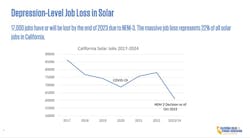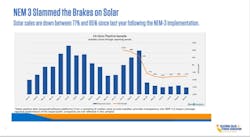Survey Reveals Future of Residential Rooftop Solar
Residential solar installer ranks in California are reportedly wobbling in the wake of significant changes to incentives which could slow rooftop installations in the short term but set the stage for growth in battery-enhanced projects down the road.
The California Solar and Storage Association (CALSSA) is out with new survey results pointing to job losses, business closures, and mounting uncertainty among member companies following changes to the state’s net metering program that has helped support the market. CALSSA says solar and storage installers were on track to shed up to 17,000 jobs by year-end 2023, almost one-quarter of the state’s solar workforce (Fig. 1). Almost 60% of firms polled expect further layoffs, 70% are concerned about the outlook for their businesses, and 40% believe they might not make it through the winter.
The dire outlook stems from a California Public Utility Commission action that slashes the pivotal credit those with new rooftop solar systems will be able to get for sending generated power back to their utility. Compared with the net metering (NEM 2.0) program that it replaces, CPUC’s new NEM 3.0 program will reduce the credit by 75% on average by some estimates, a function of utilities now deeply devaluing power exported during non-peak hours (daytime periods when solar is generating more power) but paying a premium for electricity exported during periods of peak usage and high grid stress, roughly 4 p.m. to 9 p.m. Thus, the new formula, which also incentivizes non-peak power usage, translates to much greater benefits going to rooftop systems that employ batteries to store electricity generated during non-peak hours and utilize it (or export it) during peak periods.
With standalone (non-storage) rooftop systems now effectively more costly because of longer payback periods — and battery add-ons carrying high upfront costs further upping the investment — California’s solar industry is bracing for prolonged demand slowdown and uncertainty.
Ahead of the April 15 effective date for NEM 3.0-covered installation, rooftop sales, and utility interconnection applications surged to beat the new restrictions. But in the months since, CALSSA says data show activity has plummeted, with April sales halved from a year earlier and September year-over-year (YOY) sales ending down 77% (Fig. 2). Interconnection application numbers were similarly down, confirming for CALSSA that, for many, the math largely no longer worked for rooftop solar. In a press release announcing the survey results, CALSSA said CPUC's decision to drastically alter the fundamental economics of rooftop solar would have far-reaching consequences.
“CPUC commissioners claimed their decision was about ‘launching the solar and storage industry into the future.’ Instead, they caused the nation’s largest-ever loss of clean energy jobs, pushed once thriving businesses out of the state or into bankruptcy, and derailed California’s fastest and most accessible path to a clean energy future.”
Data from a widely followed recent quarterly report on the U.S. solar market support predictions that California’s residential solar market is due to slow, a direct result of the net metering changes. The Solar Energy Industries Association/Wood Mackenzie U.S. Solar Market Insight report for Q4 2023 forecasts 13% growth in residential solar nationwide in 2023, with California’s surge being a big contributor. NEM 3.0 “drove a dramatic increase in residential sales,” the report notes, and the sales backlog drove a subsequent spike in installation growth. But it forecasts a “precipitous” drop in installations in early- to mid-2024. That drop-off in California volume will be a big contributor to a predicted 12% national contraction in residential solar installations in 2024. A national rebound will ensue in 2025, it predicts, and installations will climb steadily through 2028.
A post-NEM 3.0 rebound in California residential installations will almost surely turn on the demand for and supply of battery storage. Converts will likely be pressed into making new calculations about more costly installations, while the installer base will have to remain intact enough to respond to eventual demand recovery and grounded enough in the battery side of installations to handle more projects with a storage component. In a key state, questions may now loom on both counts.


